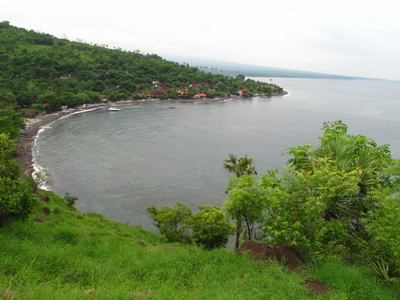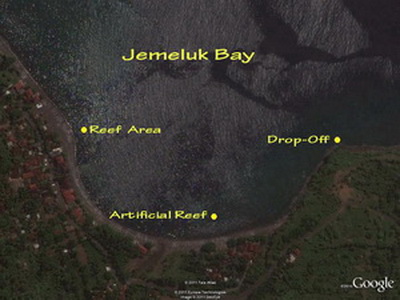
Like its neighbor Ghost Bay, Jemeluk Bay also suffered from the harvesting of hard coral that took place in the late 1980’s, during the early years of Bali’s tourist boom.
The coral mining was predominantly in the north-east of Bali and was very extensive – employing nearly 3000 people at its peak.
Ironically, the coral was used as building mortar in the construction of the first hotels & restaurants in the Amed and Candi Dasa areas…
But Jemeluk Bay also suffered from the double-whammy of severe coral bleaching in April-May 1998, when El Nino was at its very worst.
Although the hard corals in the inner bay area were badly damaged by this combination of man-made and natural events, they have recovered quite strongly in recent years, which is basically a testament to the profound fecundity of the Indonesian Throughflow as it makes its way down the north-east coast of Bali in to the Lombok Channel.
The coral gardens at the eastern tip of the bay, at what is called the Drop-Off, are now in superb condition and are possible the most prolific in Bali!
Diving Indonesia: Bali – Jemeluk Bay Drop-Off

The Drop-Off at the eastern tip of Jemeluk Bay is, as the name suggests, a steep slope that drops down into the depths.
The slope itself is an interesting dive as there is often a chance to see a cruising pelagic out in the blue, but without doubt the best part of the Drop-Off is the shallow area near the point where the huge gorgonian fans and deep red barrel sponges are simply stunning.
The presence of so many big gorgonian fans is always a sign of strong current flows, which can make this a challenging area of the Drop-Off to dive without damaging the beautiful things you have come to see!
Great care is needed to ensure that the current does not carry you in to the fans, particularly when taking photographs.
But your care & patience will be rewarded because it is a real privilege to settle down and watch the rich display of hundreds of colorful anthias surging out from the gorgonians in to the current – truly a beautiful spot to be!
[slideshow id=83]
The superb coral gardens at Jemeluk Drop-Off
Diving Indonesia: Bali – Jemeluk Bay Artificial Reef
In the early 1990’s a joint effort by local fisheries and the research institute for marine fisheries saw a a series of pyramid structures built in the inner bay area from a mixture of concrete slabs and car tires in an attempt to correct the coral mining sins of the past and provide a series of small marine fish habitats.
Although partially successful, these structures have not really been a roaring success, but they are worth exploring on the way to and back from the Drop-Off.
[slideshow id=84]
Jemeluk Artificial Reef Image Gallery
Diving Indonesia: Bali – When to dive Jemeluk Bay in Amed, North-East Bali
Jemeluk Bay is a shore dive, and as such quite easy to dive – the exception being when the wind is from the north-west, as this produces big waves & surf, which means getting in and out can be quite difficult.
The best time of year to dive the site is October & November after the southeast (dry season) monsoon has ended, but before the northwest one (wet season) has begun, and when you will get the calmest conditions and best visibility.
The period at the the start of the southeast monsoon in May through to about mid July also offers good conditions, but after that for about 2 to 2.5 months high winds create rough seas and poor conditions. Around the end of September the conditions start to improve again.
Next Page: The Japanese Wreck at Lippah Bay, Banyuning
Back To: Ghost Bay in Amed, North-East Bali
